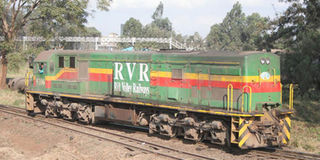Rail firm seeks Sh23bn to fund five-year revival plan

Rift Valley Railways has entered into a deal with six international financiers and a local bank to raise Sh22.9 billion for its five-year turnaround plan. PHOTO | FILE
What you need to know:
- RVR chief executive officer Carlos Andrade said the magnitude of the investment set to revive railway transport has been raised by infrastructural degradation and the extensive damage to the railway built over 110 years ago.
- However, freight traffic along Kenya’s oldest cargo transport infrastructure has turned out to be an headache for the regional investor, which was handed the management of the railway by the government in 2006.
- RVR chief commercial officer Andreas Heinel said despite the massive challenges of turning around the degraded structures, they are focused on taking advantage of available opportunities including availability of skilled labour.
Rift Valley Railways has entered into a deal with six international financiers and a local bank to raise Sh22.9 billion for its five-year turnaround plan.
The debt plan with the African Development Bank, Germany’s KfW Bankengruppe, International Finance Corporation, the Dutch Development Bank, ICF Debt Pool, Belgian Investment Company for Developing Countries and Equity Bank would help it raise fresh capital.
The financing is meant to plug a deficit that emerged after estimates by the government on funds needed to revive railway transport turned out to be seven times less than the required amount.
RVR chief executive officer Carlos Andrade said the magnitude of the investment set to revive railway transport has been raised by infrastructural degradation and the extensive damage to the railway built over 110 years ago.
“The original investment estimates from our regulators here required that we needed only $40 million (Sh3.72 billion) but is has turned out to be over $287 million (Sh26.6 billion) and we have had to source for the huge difference to achieve our turnaround plan. We are not giving up even though the task ahead is not only huge but full of challenges,” Mr Andrade said.
NEW LOCOMOTIVES
Some success in cargo freight was recorded last year according to this year’s Economic Survey.
Data from the Kenya National Bureau of Statistics released last week indicated that railway freight traffic grew by 24.3 per cent last year compared to 2013 with earnings recording a 13 per cent jump to Sh5.2 billion in 2014.
The growth is attributed to the introduction of new locomotives.
However, freight traffic along Kenya’s oldest cargo transport infrastructure has turned out to be an headache for the regional investor, which was handed the management of the railway by the government in 2006.
RVR says asset constraints, cargo export bureaucracies and taxes, including fuel levy that is meant to construct roads (a rival means) and tax meant to aid the expansion of the standard gauge railway, have made the trade hard.
“We have had to lay 140 kilometres of new tracks between Nairobi and Mombasa with others totalling to $58 million. We bought over 20,000 wheels and improved the wagons that could hardly carry loads more than what the roads trucks do,” said Mr Andrade.
The situation has left RVR with little option but to inject fresh capital to keep the wheel on steel along the 1,300km line between Mombasa and Kampala.
The latest such investment is the Sh2.3 billion order for 20 new locomotives from General Electric.
Thirteen have so far been delivered, six are on the way while one is expected this month. The locomotives will replace the aging fleet inherited from Kenya Railways.
Under the agreement signed between RVR and Kenya and Uganda governments, the firm is required to pay an annual concession fee of 11.1 per cent of gross revenues to each country, invest at least $40 million in capital and infrastructure improvements and meet rolling targets for volume haulage and maintenance of track standards.
LUNATIC EXPRESS
RVR is also supposed to run the commuter train until June even though the government controls fare rates without providing any financial input.
“We’ve met all these obligations and up to date, paid $60 million in concession fees to both governments, invested threefold in the industry just midway the concession period and we believe the turnaround is possible as long as we get the necessary support in operational environment,” Mr Andrade told Smart Company.
RVR chief commercial officer Andreas Heinel said despite the massive challenges of turning around the degraded structures, they are focused on taking advantage of available opportunities including availability of skilled labour.
“It’s a continuous investment process, the recent oil discoveries, the huge infrastructural plans and the growing regional integration that will boost export business are all opportunities for us,” said Mr Heinel
“We are happy that the Mombasa port is expanding and we hope that we will turn around sooner than most people expect.”
Rift Valley Railway took over the operations of the Kenya and Uganda Railways for a 25-year concession involving rehabilitation, operation and maintenance of the firm previously run by the Kenya Railways Corporation and Uganda Railways Corporation respectively.
The current rail network in Kenya is the metre gauge commonly referred to as ‘The Lunatic Line’.
The government has, however, embarked on the construction of a standard gauge railway at an estimated cost of Sh327 billion from Mombasa to Nairobi.





